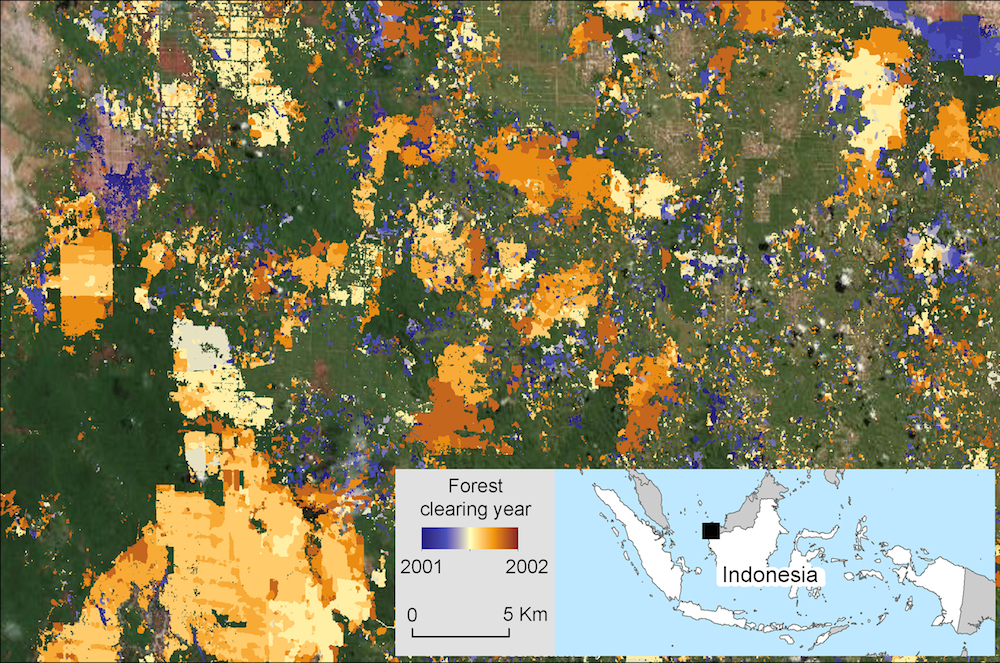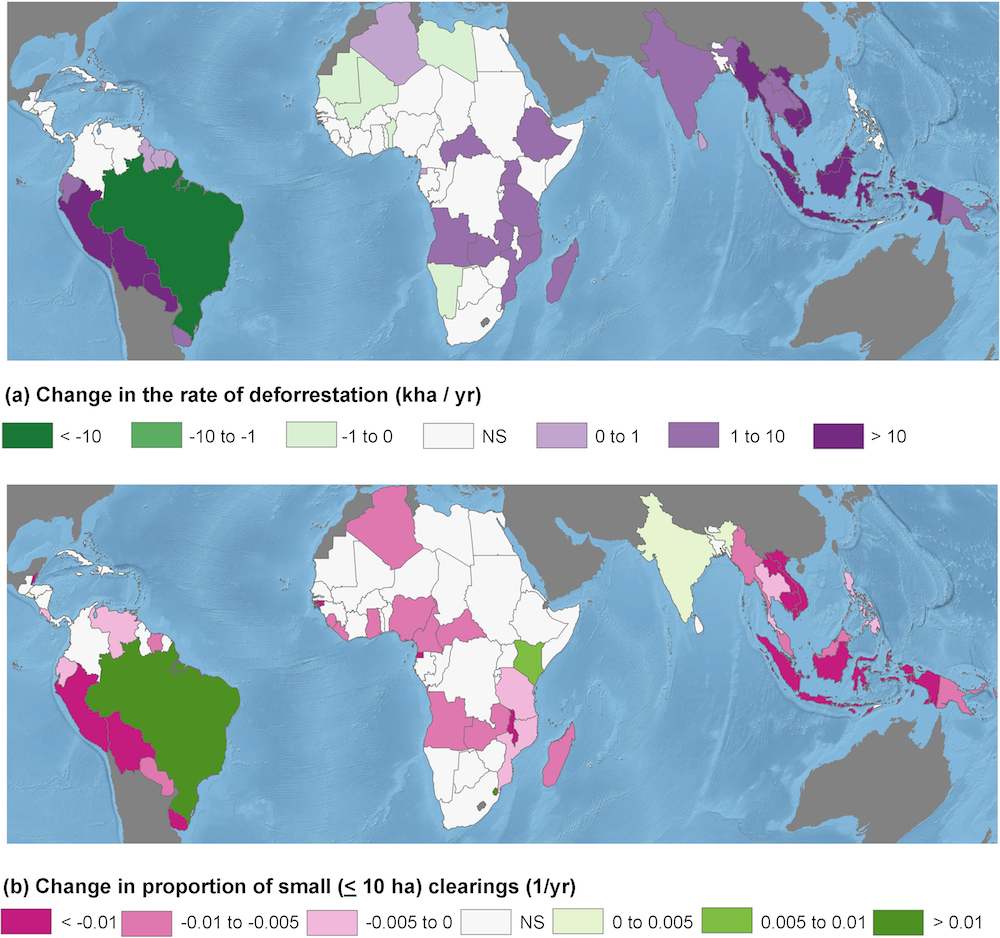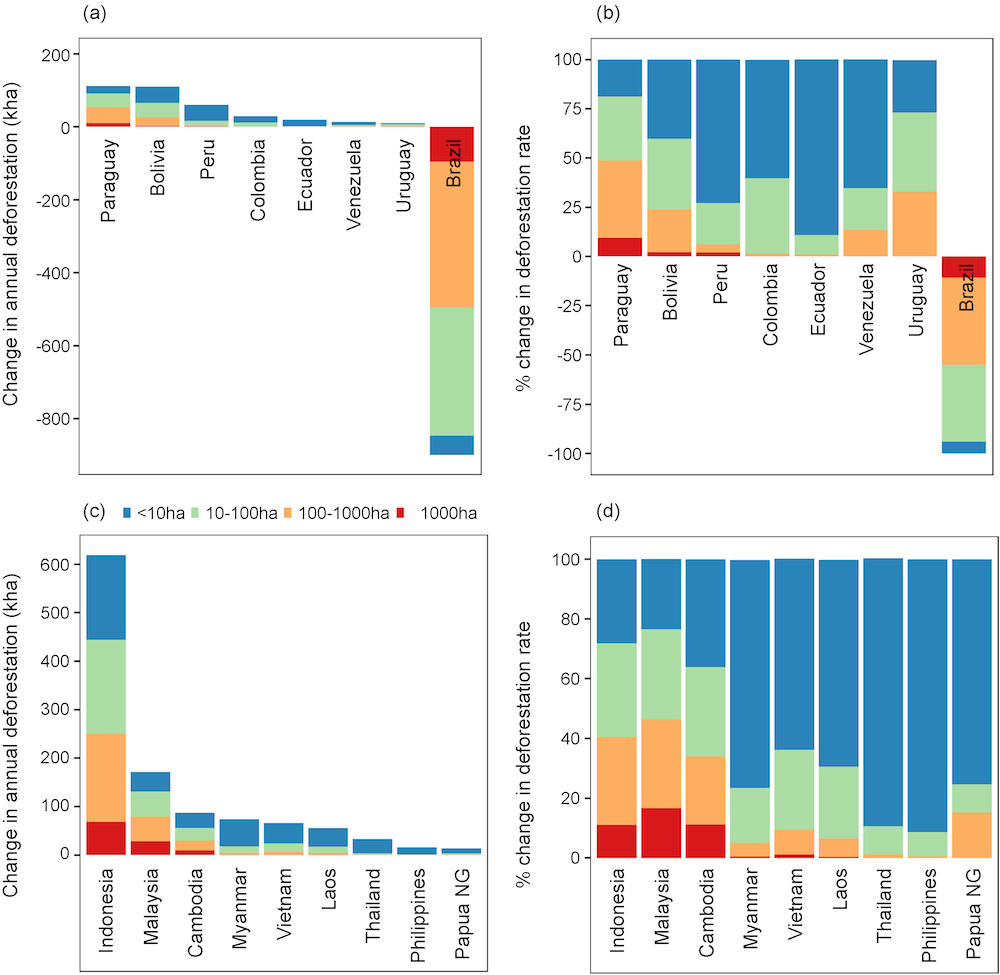- An analysis of satellite data reveals the proportion of tropical deforestation comprised of medium, large and very large clearings increased between 2001 and 2012.
- These larger clearing sizes are generally attributed to industrial agriculture like palm oil production.
- South America and Southeast Asia had the biggest increases, with the exception of Brazil where large-scale clearing took a downturn during the study period.
- The researchers say this downturn was the result of successful deforestation reduction policies, which may offer potential solutions to other countries with high rates of large-scale clearing.
As nations race to keep forests standing and the world from warming, scientists are trying to figure out what human activities are causing deforestation and how best to stop them. A study published last week in Environmental Research Letters lends some new insights, finding the majority of forest loss in the tropics is due to medium- and large-scale clearing – hallmarks of industrial agriculture. The researchers who authored the study say policy changes are needed to reduce deforestation for commodity crops like palm oil.
For their study, researchers at Duke University in the U.S. analyzed tree cover loss data detected by satellites between 2001 and 2012 and compiled by the University of Maryland. They restricted their analysis to tropical areas as defined by the UN’s Food and Agriculture Organization (FAO).
They then analyzed tree cover loss trends in respect to four deforestation class sizes: less than 10 hectares, 10 to 100 hectares, 100 to 1,000 hectares and more than 1,000 hectares. According to the FAO, household and other small-scale farms in tropical, developing nations tend to clear less than 10 hectares, so the authors used this number to define smallholder operations.
The data indicate that in the tropics overall, deforestation increased 53 percent between 2001 and 2012, from an average of around 69,000 square kilometers (6.9 million hectares or 26,600 square miles) per year during the first half of their study period to 79,000 square kilometers per year during the last half.
When they looked at the scale of discrete deforestation events, the researchers found more than half were larger than 10 hectares.
This trend, they write, was most apparent in South America and Southeast Asia, where 79 percent of tropical deforestation occurred. In South America, the researchers found that small clearings contributed 42 percent to South America’s overall deforestation and 67 percent to Southeast Asia. In comparison, small clearing events accounted for more than 80 percent of overall deforestation in other regions.
Overall, the researchers found the proportion of deforestation comprised of medium, large and very large clearings increased from 2001 to 2012. In Southeast Asia, that number went up 16 percent.



They write that their findings suggest a continuing shift from small- to large-scale industrial deforestation. Indeed, the two countries with the highest proportions of large-scale clearing – Indonesia and Malaysia – produce the lion’s share of the global palm oil supply. As the palm oil industry expands to new frontiers like Central Africa and South America, conservationists worry about potential impacts to forests and the wildlife they contain. (However, palm oil expansion hasn’t necessarily led to more deforestation in places where it can be grown on previously degraded land.)
One potentially bright spot the study uncovered is Brazil. The researchers found deforestation took a nosedive in the country between 2001 and 2012, mostly due to a reduction in large-scale clearing. While data from 2016 and 2017 indicate forest loss may again be on the rise, the Duke researchers say Brazil’s deforestation reduction policies have largely been successful and offer promise and models for other tropical forest countries.
“Similar policy levers may be effective at reducing large-scale clearings in other regions and countries, including for example emerging voluntary sustainability commitments, which aim to eliminate deforestation from the supply chains of major globally-traded commodities such as palm oil,” the authors write.

While their study brings light to the impacts and trends of large-scale, industrial deforestation, the researchers say it is also important to address small-scale clearing.
“There are many regions where small clearings continue to dominate the deforestation profile, including most of Central America and Africa,” they write. “Because small-scale conversion is often dispersed across multiple communities with diverse motivations and governing principles, the policy levers for addressing this type of conversion are more varied, and must be tailored to locally-specific contexts.”
The researchers acknowledge that their study focused on solely analyzing the sizes of deforestation events and urge their specific causes be studied more thoroughly. It’s also important to note that the dataset they used does not differentiate between natural deforestation and the harvesting of tree plantations, which means deforestation could be lower than their data indicate – particularly in plantation-heavy countries like Indonesia. However, the authors write that they crosschecked this dataset with another for Indonesia, which didn’t reveal any major discrepancies.
The authors ultimately hope the findings of their study will help inform policymakers and pave the way for greater understanding of tropical deforestation and its harmful effects such as habitat loss for wildlife like orangutans.
“Deforestation is increasing across the tropics, resulting in well-documented negative impacts on ecosystem functions and services,” they write. “In order to effectively address this deforestation, interventions must be underpinned by improved understanding of the drivers of forest loss that they target.”
Citation:
- Austin, K. G., González-Roglich, M., Schaffer-Smith, D., Schwantes, A. M., & Swenson, J. J. (2017). Trends in size of tropical deforestation events signal increasing dominance of industrial-scale drivers. Environmental Research Letters, 12(5), 054009.
FEEDBACK: Use this form to send a message to the editor of this post. If you want to post a public comment, you can do that at the bottom of the page.
